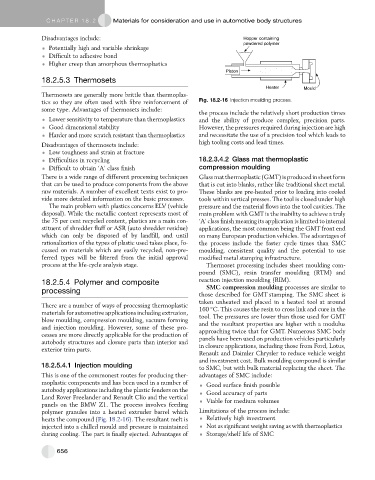Page 648 - Automotive Engineering Powertrain Chassis System and Vehicle Body
P. 648
CHAP TER 1 8. 2 Materials for consideration and use in automotive body structures
Disadvantages include: Hopper containing
powdered polymer
Potentially high and variable shrinkage
Difficult to adhesive bond
Higher creep than amorphous thermoplastics
Piston
18.2.5.3 Thermosets
Heater Mould
Thermosets are generally more brittle than thermoplas-
tics so they are often used with fibre reinforcement of Fig. 18.2-16 Injection moulding process.
some type. Advantages of thermosets include:
the process include the relatively short production times
Lower sensitivity to temperature than thermoplastics and the ability of produce complex, precision parts.
Good dimensional stability However, the pressures required during injection are high
Harder and more scratch resistant than thermoplastics and necessitate the use of a precision tool which leads to
high tooling costs and lead times.
Disadvantages of thermosets include:
Low toughness and strain at fracture
Difficulties in recycling 18.2.3.4.2 Glass mat thermoplastic
Difficult to obtain ‘A’ class finish compression moulding
There is a wide range of different processing techniques Glass matthermoplastic(GMT) isproducedinsheetform
that can be used to produce components from the above that is cut into blanks, rather like traditional sheet metal.
raw materials. A number of excellent texts exist to pro- These blanks are pre-heated prior to loading into cooled
vide more detailed information on the basic processes. tools within vertical presses. The tool is closed under high
The main problem with plastics concerns ELV (vehicle pressure and the material flows into the tool cavities. The
disposal). While the metallic content represents most of main problem with GMT is the inability to achieve a truly
the 75 per cent recycled content, plastics are a main con- ‘A’ class finish meaning its application is limited to internal
stituent of shredder fluff or ASR (auto shredder residue) applications, the most common being the GMT front end
which can only be disposed of by landfill, and until on many European production vehicles. The advantages of
rationalization of the types of plastic used takes place, fo- the process include the faster cycle times than SMC
cussed on materials which are easily recycled, non-pre- moulding, consistent quality and the potential to use
ferred types will be filtered from the initial approval modified metal stamping infrastructure.
process at the life-cycle analysis stage. Thermoset processing includes sheet moulding com-
pound (SMC), resin transfer moulding (RTM) and
18.2.5.4 Polymer and composite reaction injection moulding (RIM).
processing SMC compression moulding processes are similar to
those described for GMT stamping. The SMC sheet is
taken unheated and placed in a heated tool at around
There are a number of ways of processing thermoplastic 160 C. This causes the resin to cross link and cure in the
materials for automotive applications including extrusion, tool. The pressures are lower than those used for GMT
blow moulding, compression moulding, vacuum forming and the resultant properties are higher with a modulus
and injection moulding. However, some of these pro- approaching twice that for GMT. Numerous SMC body
cesses are more directly applicable for the production of panels have been used on production vehicles particularly
autobody structures and closure parts than interior and in closure applications, including those from Ford, Lotus,
exterior trim parts.
Renault and Daimler Chrysler to reduce vehicle weight
and investment cost. Bulk moulding compound is similar
18.2.5.4.1 Injection moulding to SMC, but with bulk material replacing the sheet. The
This is one of the commonest routes for producing ther- advantages of SMC include:
moplastic components and has been used in a number of Good surface finish possible
autobody applications including the plastic fenders on the Good accuracy of parts
Land Rover Freelander and Renault Clio and the vertical
Viable for medium volumes
panels on the BMW Z1. The process involves feeding
polymer granules into a heated extruder barrel which Limitations of the process include:
heats the compound (Fig. 18.2-16). The resultant melt is Relatively high investment
injected into a chilled mould and pressure is maintained Not as significant weight saving as with thermoplastics
during cooling. The part is finally ejected. Advantages of Storage/shelf life of SMC
656

